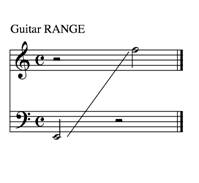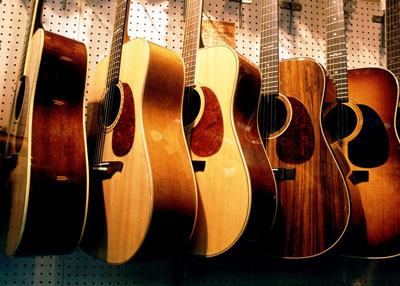Guitar
It is possible that the forerunner of the guitar came from ancient Babylonia (1900 BC). Later, guitar-like instruments were found in Egyptian and Roman civilizations (30 BC). These instruments had different numbers of strings from two to five.
The early guitars were acoustic and used different materials for the strings. Modern acoustic guitars use nylon or steel strings. The different types of strings produce different qualities of sound. Nylon strings produce a little softer sound and steel strings produce a little brighter sound.
The modern guitar has six strings. This became the standard number during the nineteenth century. From lowest to highest, the current strings are E-A-D-G-B-E.

In 1932 the guitar was changed forever. George Beauchamp and Adolph Rickenbacker built the first commercial electric guitar. It had pickups that were attached to an acoustic instrument. These pickups acted as microphones to pick up the sound and amplify it. This new technology allowed the guitar to be played louder and in more settings.
In 1950 the first solid body electric guitar was produced by Leo Fender. One of the early performers to adopt the electric guitar was Les Paul who played a Gibson Les Paul model guitar. Les Paul was also a pioneer in the development of modern studio recording techniques. He did, however, get his start as an outstanding guitar player.
There are a huge variety of guitars available today. Some are acoustic, some are electric, some have twelve strings, some use nylon strings, and some use steel strings. Guitar strings are traditionally plucked either with the fingers or sometimes with a pick, which is a small triangular device, often made of plastic.
Guitars can be found in concert settings, jazz clubs, rock and roll videos, and street corners. The guitar is a very versatile instrument that can fit into almost any ensemble.
Study the image provided and listen to the sound sample of the guitar to gain an understanding of this instrument.
![]() Listen to a sample of the guitar:
Listen to a sample of the guitar:
